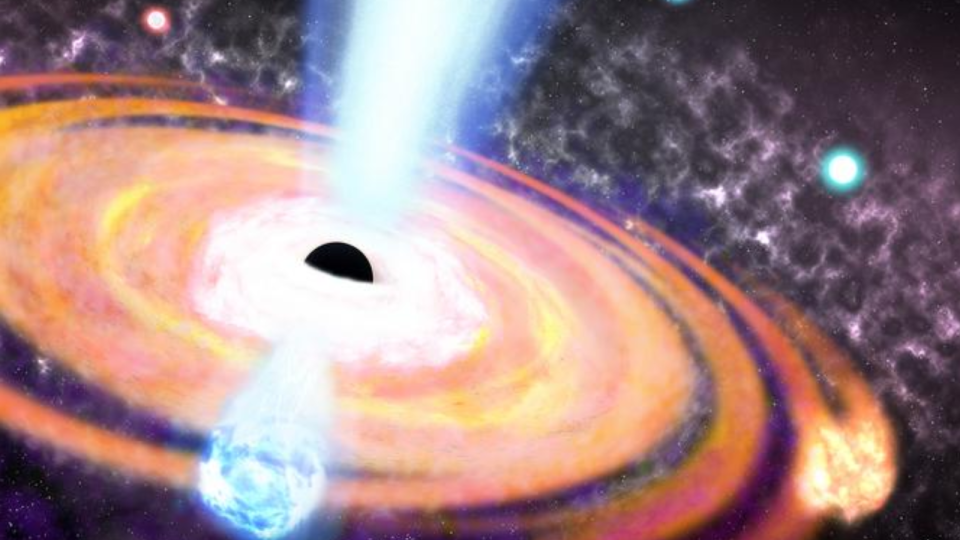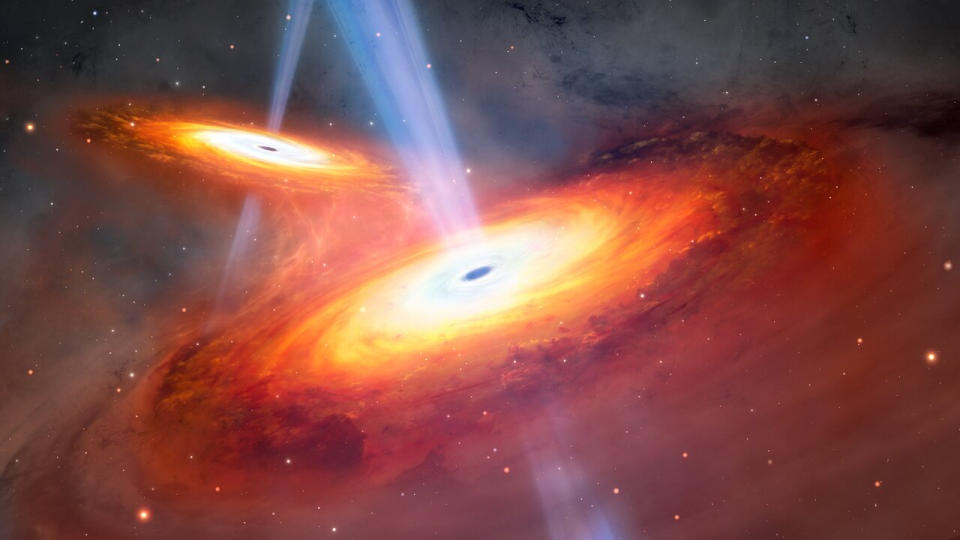Forget the “little green men” — it’s the “little red dots” in the early universe that caught the attention of the James Webb Space Telescope (JWST).
The strange red bodies, scientists say, hide stars that models suggest are “too old” to have existed in early cosmic times and black holes thousands of times more massive than the supermassive black hole at the heart of the Milky Way. Scientists believe these objects must have been born in a way unique to the early universe — by a method that appears to have ceased in the cosmos after about 1 billion years of existence.
The three little red dots are seen as they were when the universe was between 600 million and 800 million years old. While that may seem like an enormous amount of time after the Big Bang, the fact that the universe is 13.8 billion years old means that it was only 5% of its current age when these objects existed.
By confirming the existence of these dots in the early universe, these JWST findings could challenge what we know about the evolution of galaxies and the supermassive black holes they contain.
Related: James Webb Space Telescope Observes Never-Before-Seen Stellar Behavior in Distant Nebula (Video, Photo)
The team, led by scientists from Penn State University, discovered these mysterious, crimson cosmic oddities while probing the early universe with the JWST’s Near Infrared Spectrograph (NIRSpec) instrument as part of the RUBIES survey.
“It’s very confusing,” team member Joel Leja, an assistant professor of astronomy and astrophysics at Penn State, said in a statement. “You can make this fit uncomfortably into our current model of the universe, but only if we invoke an exotic, insanely fast formation at the beginning of time.
“This is without a doubt the most extraordinary and interesting collection of objects I have seen in my career.”
What’s behind the dots?
The researchers studied the intensity of different wavelengths of light coming from the tiny red dots, revealing signs that the stars are hundreds of millions of years old — much older than expected for stars at this early stage in the cosmos.
The researchers also saw evidence of supermassive black holes in the small red dot regions, with masses equal to millions, sometimes even billions, of suns. These black holes are between 100 and 1,000 times more massive than Sagittarius A* (Sgr A*), the supermassive black hole at the heart of the Milky Way, which lies just 26,000 light-years from Earth.
Neither discovery is expected under current models of cosmic evolution, galaxy growth, or supermassive black hole formation. All of these theories suggest that galaxies and supermassive black holes grow at the same rate — but this growth takes billions of years.
“We have confirmed that these stars appear to be full of old stars – hundreds of millions of years old – in a universe that is only [600 million to 800 million years] old. Remarkably, these objects hold the record for the earliest signatures of ancient starlight,” study leader Bingjie Wang, a postdoctoral researcher at Penn State, said in the statement. “It was completely unexpected to find ancient stars in a very young universe. The standard models of cosmology and galaxy formation have been incredibly successful, but these luminous objects don’t fit comfortably into those theories.”

The team first spotted the tiny red dots while using the JWST in July, and the researchers immediately suspected that the objects were actually galaxies that existed about 13.5 billion years ago.
Further investigation of the light spectra of these objects confirmed that they were galaxies that were already alive at the beginning of time. It also turned out that ‘overgrown’ supermassive black holes and impossibly ‘old’ stars caused the impressive light output of the red dots.
The team isn’t yet sure how much of the light from the little red dots is coming from each of these sources. That means these galaxies are either unexpectedly old and more massive than the Milky Way, forming much earlier than models predict, or they have normal amounts of mass but somehow still have exaggeratedly massive black holes — voids that are much more massive than a comparable galaxy would have in the current era of the cosmos.
“It’s challenging to distinguish between light from material falling into a black hole and light emitted by stars in these small, distant objects,” Wang said. “That inability to tell the difference in the current dataset leaves plenty of room for interpretation of these intriguing objects.”
That’s no ordinary supermassive black hole!
Of course, all black holes have light-catching boundaries, called “event horizons.” That is, however much light they contribute to the little red dots, it must come from the material surrounding them, not from within.
The enormous gravitational influence of the black holes generates turbulent conditions in this material, which over time feeds the black hole, heating it up and causing it to glow brightly. Regions powered by supermassive black holes in this way are called “quasars,” and the regions of their galaxies in which they reside are known as “active galactic nuclei (AGNs).”
These newly discovered “red dot” black holes may be different from other quasars, even those the JWST has seen in the early universe. For example, the red dot black holes appear to produce much more ultraviolet light than expected. Yet the most shocking thing about these supermassive black holes is how massive they appear.
“Normally, supermassive black holes are paired with galaxies,” Leja said. “They grow up together and go through all their important life experiences together. But here we have a fully formed adult black hole living in what should be a baby galaxy.
“That doesn’t really make sense, because these things should grow together. At least that’s what we thought.”


The red dot galaxies themselves are also surprising. They appear to be much smaller than other galaxies, despite having almost the same number of stars. That means the red dot galaxies appear to be made up of between 10 billion and 1 trillion stars, crammed into a galaxy a few hundred light-years across with a volume 1,000 times smaller than the Milky Way.
To put that in context, if the Milky Way were shrunk down to the size of one of these red dot galaxies, the closest star to the Sun (Proxima Centauri, which is 4.2 light-years away) would be inside the Solar System. Furthermore, the distance between Earth and the Milky Way’s supermassive black hole, Sgr A*, would be reduced from 26,000 light-years to just 26 light-years. It and its surroundings would then appear above Earth in the night sky.
“These early galaxies would be so full of stars — stars that would have formed in a way that we’ve never seen before, under conditions that we would never expect at a time when we would never expect them,” Leja said. “And for whatever reason, the universe stopped making objects like these after just a few billion years. They’re unique to the early universe.”
RELATED STORIES:
— Iconic Crab Nebula Shines in Stunning Images from the James Webb Space Telescope
— James Webb Space Telescope Sees Orion Nebula in Stunning New Light
— Pink nebula glows in stunning new ESO telescope image
The team plans to follow up on its findings with more observations of these puzzling little red dots to better understand the mysteries of the dots. This includes obtaining deeper spectra by pointing the JWST at the red objects for longer periods of time to obtain emission spectra of light associated with different elements. This could help unravel the contributions of old stars and supermassive black holes in the galaxies.
“There is another way we can achieve a breakthrough, and that is simply [having] “The right idea,” Leja concluded. “We have all these puzzle pieces, and they only fit if we ignore the fact that some of them break. This problem lends itself to a stroke of genius that has eluded us, all of our collaborators, and the entire scientific community until now.
“Honestly, it’s exciting that there’s still so much of this mystery to be solved.”
The team’s research was published June 26 in the journal Astrophysical Journal Letters.